University of Durham
| University of Durham | |
|
Fundamenta eius super montibus sanctis | |
|---|---|
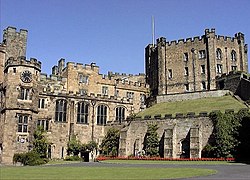 Durham Castle – University Collage | |
 | |
| Founded: | 1832 |
| Chancellor: | Sir Thomas Allen |
| Endowment: | £71.1 million (exclusive of Colleges) |
| Website: | www.dur.ac.uk |
| Location | |
| Location: | 54°46’23"N, 1°34’26"W |
The University of Durham is a collegiate university in the City of Durham, with a second campus in nearby Stockton-on-Tees, both in County Durham. The University was founded by an Act of Parliament in 1832 and granted a Royal Charter in 1837. It was the first extant university founded in England in 600 years, and at its foundation the only one other than Oxford and Cambridge. It is the eighth-oldest in the British Isles.
The Durham University estate includes 63 listed buildings, ranging from the 11th-century Durham Castle to a 1930s Art Deco Chapel. The university also owns and manages the Durham [[World Heritage Site in partnership with Durham Cathedral. The university buildings which form part of the of the World Heritage Site includes Durham Castle, Palace Green, and the surrounding buildings including the historic Cosin's Library.[1]
As a collegiate university, its main functions are divided between the academic departments of the university and 16 colleges. In general, the departments perform research and provide lectures to students, while the colleges are responsible for the domestic arrangements and welfare of undergraduate students, graduate students, post-doctoral researchers and some university staff.
The university is a member of the Russell Group of leading UK universities[2] after previously being a member of the 1994 Group. Durham is also affiliated with several university groups including the N8 Research Partnership, the Matariki Network of Universities and the Coimbra Group.
History
Origins
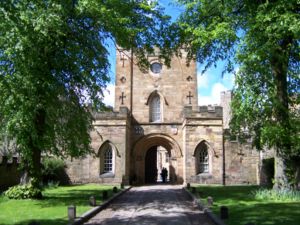
The strong tradition of theological teaching in Durham gave rise to various attempts to form a university there, notably under King Henry VIII and Oliver Cromwell, who issued letters patent and nominated a proctor and fellows for the establishment of 'Durham College' in 1657.[3] However, there was deep concern expressed by Oxford and Cambridge that the awarding of degree powers could hinder their position. Consequently, it was not until 1832 when Parliament, at the instigation of Archdeacon Charles Thorp and with the support of the Bishop of Durham, William van Mildert, passed "an Act to enable the Dean and Chapter of Durham Cathedral to appropriate part of the property of their church to the establishment of a University in connection therewith" that the university came into being. The Act received Royal Assent from King William IV on 4 July 1832.
The Church University 1832 - 1909
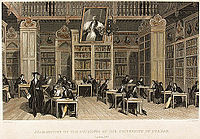
The University opened on 28 October 1833. In 1834 all but two of the bishops of the Church of England confirmed that they would accept holders of Durham degrees for ordination. In 1835 a fundamental statue was passed by the Dean and Chapter, as governors of the University, setting up Convocation and laying down that Durham degrees would only be open to members of the Church of England. Regulations for degrees were finalised in 1836 and the university was incorporated by Royal Charter granted by William IV on 1 June 1837 as the "Warden, Masters and Scholars of the University of Durham", with the first students graduating a week later. Accommodation was provided in the Archdeacon's Inn (now Cosin's Hall) from 1833 to 1837. On the accession of Queen Victoria an order of the Queen-in-Council was issued granting the use of Durham Castle (previously a palace of the Bishop of Durham) to the university.
The occupation of Durham Castle by University College makes it the oldest inhabited university building in the world.[4][5]
In 1846, Bishop Hatfield's Hall (later to become Hatfield College) was founded, providing for the opportunity for students to obtain affordable lodgings with fully catered communal eating. Those attending University College were expected to bring a servant with them to deal with cooking, cleaning and so on. Elsewhere, the university expanded from Durham into Newcastle in 1852 when the medical school there (established in 1834) became a college of the university. This was joined in 1871 by the College of Physical Sciences (renamed the College of Science in 1884 and again renamed Armstrong College in 1904). St Cuthbert's Society was founded in 1888 to cater for non-resident students in Durham (although now mainly caters for resident students), while two teacher-training colleges – St Hild's for women, established in 1858, and The College of the Venerable Bede for men, established in 1839, also existed in the city. These merged to form a mixed college (the College of St Hild and St Bede) in 1975. From 1896 these were associated with the university and graduates of St Hild's were the first female graduates from Durham in 1898.
During the expansion phase the University also became the first British university to establish relationship with overseas institutions.[6] Firstly in 1875 with Codrington College in Barbados, and secondly in early 1876 with Fourah Bay College in Sierra Leone.[7] Under the arrangements the two colleges became affiliated colleges of the university with their students sitting examinations for and receiving Durham degrees.[7][8] The landmark event was not met with universal applause: The Times stated that "it would not be much longer before the University of Durham was affiliated to the Zoo".[9] After nearly a century of affiliation and with the prevailing winds of decolonization Fourah Bay became independent of the university in 1968 to form part of the University of Sierra Leone, while Codringon College retained its affiliation with the university until the 2000s.[10][10]
The first debating society in Durham was founded in 1835. This may have closed by 1839. In 1842, the Durham University Union was established and later revived in 1872-3, when it took up the name of the Durham Union Society and moved to Palace Green.[11][12] The Durham Colleges Students Representative Council (SRC) was founded c. 1900 after the model of the College of Medicine SRC (in Newcastle). The Durham University SRC was formed in 1907 with representatives from the Durham Colleges, the College of Medicine, and Armstrong College (also in Newcastle). In 1963, after the creation of Newcastle University, the Durham Colleges SRC became the Durham University SRC, and was renamed as the Durham Students' Union in 1970.[13]
Until the mid 19th century, University of Durham degrees were subject to a religious test and could only be taken by members of the established church. Medical degrees in Newcastle were exempt from this requirement from the start of the affiliation of the Medical school, but in Durham it lasted until the revision of the statutes in 1865.[14] Despite the opening of degrees, staff and members of Convocation were still required to be members of the Church of England until the Universities Tests Act 1871. However, "dissenters" were able to attend Durham and then sit the examinations for degrees of the University of London, which were not subject to any religious test.[15] Following the grant of a supplemental charter in 1895 allowing women to receive degrees of the university, the Women's Hostel (|St Mary's College from 1919) was founded in 1899.[16]
The Federal University 1909-1963
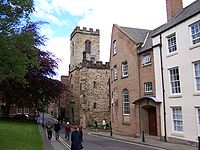
The Newcastle division of the university, which comprised both Armstrong College (named after Lord Armstrong) and Durham University College of Medicine, quickly grew to outnumber the Durham colleges, despite the addition of two independent Anglican foundations; St Chad's College (1904) and St John's College (1909). A parliamentary bill proposed in 1907 would have fixed the seat of the university in Durham for only ten years, allowing the Senate to choose to move to Newcastle after this. This was blocked by a local Member of Parliament, with the support of graduates of the Durham colleges, until the bill was modified to establish a federal university with its seat fixed in Durham. This reform also removed the university from the authority of the Dean and Chapter of Durham Cathedral, who had been the governors of the university since its foundation.[17] Thirty years after this, the Royal Commission of 1937 recommended changes in the constitution of the federal university, resulting in the merger of the two Newcastle colleges in the Newcastle Division to form King's College. The Vice-Chancellorship alternated between the Warden of the Durham Division and the Rector of the Newcastle Division.[18] (The legacy of this lives on, in that the de facto head of the university is still called "The Vice-Chancellor and Warden".).[19]
After Second World War, the Durham division expanded rapidly. St Aidan's Society (St Aidan's College from 1961) was founded in 1947 to cater for non-resident women and the decision was made to expand further on Elvet Hill (where the science site had been established in the 1920s), relocating St Mary's College, building a new men's colleges, vastly expanding the existing pure science provision in Durham, and adding applied science (1960) and engineering (1965).[20][21]
In 1947, the foundation stones for the new St Mary's College building on Elvet Hill were laid by the Princess Elizabeth (later Queen Elizabeth II).[22] The new building opened in 1952. In the same year, tensions surfaced again over the Durham-Newcastle divide, with a proposal to change the name of the university to the "University of Durham and Newcastle". This motion was defeated in Convocation (the assembly of members of the university) by 135 votes to 129.[23] Eleven years later, with the Universities of Durham and Newcastle upon Tyne Act 1963, King's College became the University of Newcastle upon Tyne, leaving Durham University based solely in its home city.[24]
The Modern University 1963-1999
By the time of the separation from Newcastle, the Elvet Hill site was well established, with the first of the new colleges, Grey College (named after the Charles Grey, 2nd Earl Grey, who was the Prime Minister when the university was founded) being founded in 1959. Expansion up Elvet Hill continued, with Van Mildert College and the Durham Business School (1965), Trevelyan College (1966) and Collingwood College (1972) all being added to the university, along with a Botanic Garden (1970).[25][26]

These were not the only developments in the university, however. The Graduate Society, catering for postgraduate students, was founded in 1965 (renamed Ustinov College in 2003) and the (now closed) Roman Catholic seminary of Ushaw College, which had been in Durham since 1808, was licensed as a hall of residence in 1968. In 1988, the last men's college (Hatfield) became mixed, followed by the women's college of Trevelyan in 1992, leaving the original women's college of St Mary's as the last single-sex college.[27]
In 1989 the university started its fund-raising and alumni office, with a virtual community for alumni[28] and several large gifts made to the university, including for the Centre for Middle Eastern Studies, the Department of Physics and the Wolfson Research Institute.
Development in Stockton 1992-1999
In 1991, a joint venture between the university and the University of Teesside saw the Joint University College on Teesside of the Universities of Durham and Teesside (JUCOT) established at Thornaby-on-Tees in the North Riding of Yorkshire, thirty miles south of Durham. It opened under the name of University College Stockton in 1992.
University College Stockton was initially intended to grant joint degrees validated by both institutions (BAs and BScs). However, Teesside, which had only become a university in 1992, had difficulties in taking on its responsibilities for the college and withdrew in 1994, Durham taking over full responsibility for UCS and the degrees to be awarded there.
A programme of integration with Durham began, with the Privy Council approving changes in Durham's statutes to make UCS a college of the University of Durham. Further integration of the Stockton development with the University led to the formation of the University of Durham, Stockton Campus in 1998 and the separation of teaching responsibilities from University College Stockton.
21st Century

In 2001, two new colleges, John Snow College and George Stephenson Collage (after the physician and the engineer respectively) were established at Stockton, replacing University College Stockton, and the new Durham University School of Medicine, Pharmacy and Health (which operates in association with the University of Newcastle upon Tyne) took in its first students – the first medics to join Durham since 1963.
In 2002, her golden jubilee year, The Queen granted the title "Queen's Campus" to the Stockton site.[29] By 2005, Queen's Campus, Stockton, accounted for around 18% of the total university student population.[30] In 2007 the campus cafeteria, "The Waterside Room", was renovated and now serves as the campus student bar. In addition to this facility both colleges at the campus benefit from their own college bars, managed centrally, however, and not by their JCRs.
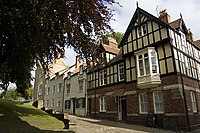
Campus
Durham University owns a 563-acre estate which includes part of a UNESCO world heritage site,[31] one ancient monument, five grade-one listed buildings and 68 grade two-listed buildings along with 44.9 ha of woodland.[32] The estate is divided across two separate locations: Durham City and Queen's Campus, Stockton. The two locations are connected via a free bus service that runs frequently throughout the week. One of the major public attractions in Durham City is the 18-acre Durham University Botanic Garden, established in 1970, with over 78,000 visitors a year (2007/08).[33][34]
Durham City
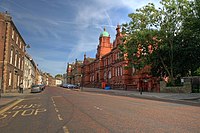
Durham City is the main location of the university and contains 14 of the 16 colleges along with most of the academic departments. The Durham City estate is spread across several different sites
The Bailey is the historic centre of the University and contains 5 colleges as well as the departments of Music and of Theology and Religion, the Institute of Advanced Study and Palace Green Library, housing the University's special collections. The Bailey is linked to Dunelm House, home of the Students Union in New Elvet, by the University's Kingsgate Bridge.
The Old and New Elvet areas contain a number of departments in Humanities and Social Sciences including Philosophy, and Sociology. The Leazes Road site on the north bank of the Wear, opposite the University's Racecourse playing fields and Old Elvet, is home to the School of Education and Hild Bede College. Old Elvet was previously the site of the university's administration in Old Shire Hall, which has, since September 2012, been based on the Mountjoy site, in the Palatine Centre on Stockton Road.[35]
The Mountjoy site (formerly the Science site) south of New Elvet contains the vast majority of departments and large lecture theatres such as Appleby, Scarborough, James Duff, Heywood and more recently the Calman Learning Centre, along with the Bill Bryson library.[36] Upper Mountjoy contains the Psychology and Biological & Biomedical schools, along with various research centres.
Elvet Hill, south of the Mountjoy site, has 8 of the colleges as well as the Botanic Garden and the Vice Chancellor's residence in Hollingside House. It is also home to the Business School and the department of Government and International Affairs, as well as the Teikyo University of Japan in Durham and the Oriental Museum. The University plans to build accommodation for 1000 students at Mount Oswald on Elvet Hill.[37] This is to be in two colleges of around 500 self-catered rooms each, with the first 700 rooms hoped to be available for the 2019/20 academic year and the remaining 300 by the 2021/22 academic year.[38]
Ustinov College is slated to move from its current site at Howlands Farm on Elvet Hill to a new site at Sheraton Park in Neville's Cross from the 2017/18 academic year. The two colleges currently at Stockton (Stephenson and John Snow) will then partly move to the current Ustinov College site in Durham in 2018/19, before one of them moves into the new development at Mount Oswald in 2019/20 and the other fully occupies the current Ustinov site. Ustinov students have launched a campaign against the move.[39]
Ushaw College, 5 miles west of Durham, is a former Catholic seminary that is a licensed Hall of Residence of the University. It hosts parts of the Business School and of the Centre for Catholic Studies. It used to house some students from Josephine Butler College, but since summer 2015 the only students at Ushaw are business marketing students.[40]
Queen's Campus

Queen's Campus was established in 1992 and is located in the town of Thornaby-on-Tees some 30 miles away from Durham, in Yorkshire. The Campus is home to around 2,000 full-time students, two residential colleges (John Snow and Stephenson Colleges) and the Wolfson Research Institute.
Libraries
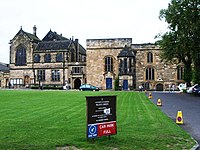
The Durham University Library system holds over 1.5 million printed items.[41] The library was founded in January 1833 at Palace Green by a 160-volume donation by the then Bishop of Durham, William Van Mildert.[41] The library operates four branches: Bill Bryson Library (the main library), Education Library, Queen's Campus Library and the Palace Green Library which holds the special and heritage collections. The Bishop Cosin's Library contains mediæval manuscripts and over 5,000 printed books, many early,[42] and the Sudan Archive ("the pre-eminent archive on the Sudan outside Khartoum"[42]) of the central library were granted Designation Status in 2005 by the Museums, Libraries and Archives Council.[42] In 2012 the university was part of a partnership with the British Library and Durham Cathedral to purchase Europe's oldest intact book, the St Cuthbert Gospel, for the nation for £9 million. It is displayed equally in London and Durham, being shown at the University's Palace Green Library for the first time as part of the Lindisfarne Gospels Durham exhibition, 1 July – 30 September 2013, and again subsequently.[43][44][45]
In addition to the central library system, each College maintains its own library and reading rooms such as the Bettenson, Brewis, Williams and Fenton Libraries of St Chad's College, which contain over 38,000 volumes.[46] Many departments also maintain a library in addition to the subject collections in the central and college libraries. Readers are also entitled to use the theology library housed by Durham Cathedral in its cloister.
Museums
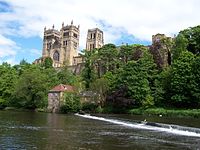
The university manages a number of museums. Built in the 1960s, the university's Oriental Museum grew predominantly from the acquisitions of the university's former School of Oriental Studies.[47] Initially housed across the university and used as a teaching collection, the size of the collection led to the building of the current museum to house the material.[47] The collection to date contains over 30,000 objects from Asian art to antiquities, covering the Orient and Levant to the Far East and the Indian Sub-continent, with over a third of the collection relating to China.[47][48] The national importance of the Chinese and Egyptian collections can been seen in the Designated Status from the Museums, Libraries and Archives Council achieved in 2008.[48][49][50]
The Old Fulling Mill is the university's Museum of Archaeology. The museum was opened in 1833 being the second university museum in England to allow admittance to the general public.[51] The museum focuses on the heritage of County Durham and Northumberland, with collections spanning the prehistoric, to Ancient Greek and Roman to the Anglo Saxon periods, although the key collection is that of the Mediæval & Post Mediæval period.[52]
Organisation and administration
Academic year
The academic year at Durham is divided into three terms: Michaelmas term, which lasts 10 weeks from October to December; Epiphany term, which lasts nine weeks from January to March; and Easter term, which lasts nine weeks from April to June. All terms start on a Monday. The weeks of term are called "Teaching Weeks", numbered from 1 (start of Michaelmas) to 28 (end of Easter), although this period is used for teaching and exams. Additionally, there is an "Induction Week" (informally known as "Freshers' Week" or Week 0) for first year students prior to the start of Michaelmas term, starting on the first Monday in October.[53]
Students at the university are also expected to "Keep Term", whereby students must fulfil their academic requirements at the university. As such Heads of Departments must be satisfied that each student has attended all necessary tutorials, seminars and practical work throughout the term and vacation period.
Colleges
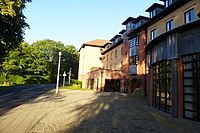
Durham operates a collegiate structure similar to that of the University of Oxford and the University of Cambridge, in that each of the colleges at Durham (and the Wesley Study Centre) are "listed bodies" for the purposes of the Education Acts as "a constituent college, school, hall or other institution of a university", although unlike Oxford and Cambridge, most of the Durham colleges are governed and owned directly by the university itself (the exceptions being St John's and St Chad's). In contrast to Oxford and Cambridge, there is no formal teaching at Durham colleges (with the exception of Cranmer Hall theological college within St John's), although colleges are active in research.[54][55][56] The colleges dominate the residential, social, sporting, and pastoral functions within the university, and there is heavy student involvement in their operation.
Formal dinners are held at every college; gowns are worn to these events at just over half of the colleges. Gowns are not worn for formals at Collingwood, St Aidan's, St Cuthbert's, Hild Bede, Van Mildert, Stephenson or Ustinov.[57][58]
There is a great deal of intercollegiate rivalry, particularly in rowing and other sporting activities. There is also rivalry between the older "Bailey" colleges and the newer "Hill" colleges.[59][60]
The colleges are:
Governance
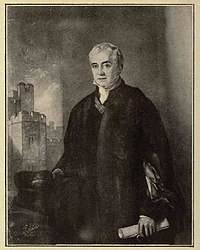
The University is governed by the Statutes put in place by the Universities of Durham and Newcastle upon Tyne Act, 1963, and subsequently amended by the Privy Council. The Statutes provide that: "The University shall be governed by a Visitor, Chancellor, Vice-Chancellor, Convocation, Council, Senate, and Boards of Studies." (Statue 4). [61]
The Visitor for the University of Durham is the Bishop of Durham. The Visitor is the final arbiter of any dispute within the university, except in those areas where legislation has removed this to the law courts or other ombudsmen, or in matters internal to the two non-maintained colleges (St Chad's College and St John's College), each of which has its own Visitor. Student complaints and appeals were heard by the Visitor until the Higher Education Act 2004 came into force.[62]
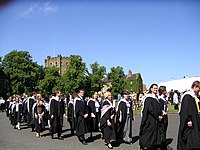
with receptions on Palace Green]]
Convocation is the assembly of members of the university. It consists of the Chancellor, Vice-Chancellor, and Pro-Vice-Chancellors, all graduates, the teaching staff (lecturers, senior lecturers, readers, and professors), and the heads of colleges and licensed halls of residence. It must meet once each year in order to hear the Vice-Chancellor's Address and to debate any business relating to the university. Further meetings can be called if representation is made by a minimum of 50 members. Its powers are limited to appointing the Chancellor (and even then, only on the nomination of Council and Senate) and the making of representations to the university on any business debated (Statue 30).[61]
Council is the executive body of the university. In addition to representatives from the university it includes up to 12 lay members (not being teachers or salaried staff in the university or any of its colleges), the Dean of Durham and the President of Durham Students' Union (Statute 10). Its powers include establishing and maintaining colleges, and recognising non-maintained colleges and licensed halls of residence (Statutes 12 & 13).
Senate is the supreme governing body of the universifty in academic matters. It nominates the Vice-Chancellor and Pro-Vice-Chancellors to Council, and recommends the establishment of Faculties and Boards of Studies. It is Senate that grants degrees, and has the authority to revoke them. It also regulates the use of academic dress of the university (Statutes 19 & 20).[61]
The day-to-day running of the University is in the hands of the University Executive Committee.
Schools and faculties
The teaching departments of the university are divided into three faculties: Science, Arts and Humanities, and Social Sciences and Health. Each faculty is headed by a Pro-Vice-Chancellor and one or more Deputies. These, along with the heads of the departments in the faculty and the Vice-Chancellor, make up the Faculty Board for that faculty. Each department also has a Board of Studies consisting of the Pro-Vice-Chancellor of their faculty, the teaching staff of the department, and student representatives (Statute 29).[61] Associated with the three faculties are three combined honours degrees: Natural Sciences (BSc & MSci), Liberal Arts (BA), and Combined Honours in Social Sciences (BA).[63]
The largest degree programmes offered by the university, by number of entrants from the 2013-14 admissions cycle, were Business, Accounting and Finance (395), Natural Sciences (221), Modern Languages and Cultures (216), and Geography (216).[64]
|
Faculty of Social Science & Health[65]
|
Faculty of Arts and Humanities[66]
|
Faculty of Science[67]
|
Research
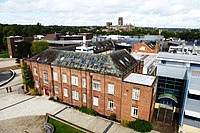
The university is part of the Russell Group, Virgo Consortium and the N8 Group of Universities.
According to the latest CWTS Leiden Ranking 2016 that measures the scientific performance of 500 major universities worldwide, Durham is ranked 61st in the world in terms of the proportion of its scientific papers in the top 10% for impact (the "PP(top 10%)" measure).[68] Furthermore, Durham's Department of Physics research into Space Science and Astrophysics was rated as number one in Europe and fourth in the world by Thomson Reuters from its Essential Science Indicators (1998–2008).[69]
Research institutes at the university include the Centre for the Advanced Study of the Arab World, the Durham Energy Institute, the Institute for Hazard and Risk Research, the Institute of Advanced Study, the International Boundaries Research Unit and the Institute for Computational Cosmology.
Centre for Iranian Studies
The Centre for Iranian Studies was founded in 1999 as a subsidiary research body of the Institute for Middle Eastern and Islamic Studies, Durham University.[70] In 2010 it was noted that the centre had commenced an official relationship with the Iranian government, using a "memorandum of understanding" to collaborate on exchange of faculty members and experts, joint research projects, activities and experiences, conferences, scientific meetings, educational workshops and joint book projects.[71]
Student life
Residential life
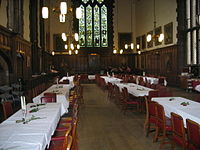
Durham students belong to a college for the duration of their time at the university. Most students live in their college for the first year of their undergraduate life, then choose to 'live-out' in their second year, and subsequently have the option of moving back into college for their final year, usually via a ballot system.[72] The Colleges provide a key role in the pastoral care and social centre of students with each running a college tutorial system,[72][73] along with Junior Common Rooms providing events and societies for undergraduate members, Middle Common Rooms being a centre for postgraduate students and the Senior Common Rooms for the college officers, fellows and tutors. These common rooms are run by an executive committee, usually headed by a President. Some colleges use other titles for the head of their JCR: Hatfield retains "Senior Man", having rejected a motion to move to "JCR President" in May 2014[74] and a motion to allow the incumbent to choose between "Senior Man", "Senior Woman" or "Senior Student" in January 2016.[75] University College voted to allow "Senior Man", "Senior Woman" or "Senior Student" in June 2015,[76] the incumbent switching to using "Senior Student",[77] and St Chad's uses "Senior Man" or "Senior Woman".[78]
Each college has a unique identity and a variety of facilities for students ranging from computer rooms and libraries to tennis courts and gyms.[79] In 2015, Durham University were voted number 1 in the UK for best university WiFi, on a review platform StudentCrowd.[80] Most colleges have their own sports teams and compete in the collegiate leagues (such as Durham College Rowing) and have their own theatre company and orchestra which operate parallel to the university level sports teams and organisations.[81]
Student organisations
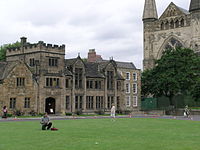
Approximately 200 student clubs and organisations run on Durham's campuses, covering academic, active, Arts, culture and faith, hobbies and games, outdoors, political and causes, and music interests.[82] Durham Students' Union charters and provides most of the funding for these organisations. The DSU runs a Comedy Café, Fresher's Ball, Silent Discos and Vintage fashion fair.[83]
Student media
- Palatinate, Durham's independent student run fortnightly newspaper, has been continually published since 1948.[84] Notable former editors include George Alagiah,[84] Hunter Davies,[85] Piers Merchant, Sir Timothy Laurence,[86] Jeremy Vine[84] and Harold Evans.[84]
- Purple Radio is Durham's student radio station. It broadcasts live from the Durham Students' Union 24 hours a day during term time. The station has existed since the 1980s and is a recognised DSU society. Two daily news bulletins are broadcast every weekday, as well as a Breakfast Show and an Evening Show.[87]
- The Bubble, founded in 2010, is an online magazine based at the university covering various subjects, including student and university news.[88]
Sport
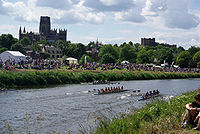
Sport at Durham is a key aspect of student life with some 92% of students regularly taking part.[89] There are 45 university level sport clubs, organised by ‘’Team Durham’’ with many being predominantly based at the Graham Sports Centre at Maiden Castle which has 26 courts and pitches for sports ranging from rugby to lacrosse to netball, additional facilities include eleven boat houses and two astroturfs a fitness studio and weights room. The university also owns The Racecourse which has a further eight courts and pitches for cricket, rugby (union and league), squash and football.[90]
The university is recognised as a Centre of Cricketing Excellence (one of only six university centres to play first-class matches)[91] by the England and Wales Cricket Board[92][93] and subsequently the Marylebone Cricket Club[94][95]
In rowing[91] and fencing[91] it is also being recognised as a centre of excellence.
Durham has been 2nd across all sports in the British Universities & Colleges Sport table since 2011/12. In rowing, it has a good record at the BUCS Regatta, having won the title for ten consecutive years (2004–2013) before coming second in 2014, then regaining the title in 2015. Durham University Boat Club also competes in Durham Regatta and the Boat Race of the North against Newcastle University, which ran 1997 - 2010 and was revived in 2015.[96]
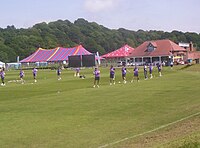
Durham University is one of four universities to compete in the unofficial "Doxbridge" Tournament in Dublin, a sporting competition between Durham University, the University of Oxford, the University of Cambridge and the University of York.[97] Durham colleges also compete officially with colleges from the University of York in the annual College Varsity tournament held since 2014.[98] Durham won this tournament in 2014 (in York) and 2015 (in Durham) before York recorded their first victory in 2016 (in York). Durham also competes again long-standing BUCS champions Loughborough University in the 'BUCS Varsity', a coordinated set of BUCS matches across multiple sports, and in a competition between Durham colleges and Loughborough halls of residence, both of which were organised for the first time in 2015/16. Durham won the BUCS Varsity both home and away in 2015/16 but lost the colleges' competition, held in Durham.[99]
‘Palatinates’ are given to athletes who demonstrate a high standard (such as international representation) in their sport. It is similar to a blue awarded at other British universities. The award is named after the colour palatinate associated with the university.
Music and drama
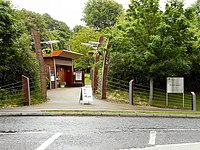
The central body for theatre at the university is known as Durham Student Theatre (DST),[100] which comprises around 600 active student members throughout 29 separate, student-run theatre societies as of 2016.[101] The Assembly Rooms is the university-owned theatre, located on The Bailey, which hosts a number of student productions each term. Alongside this, student drama productions are held at Durham City's Gala Theatre (notably Durham University Light Opera Group and Durham Opera Ensemble, which both perform one show in the Gala every year in Epiphany term), venues around Durham University and within the colleges, Durham Castle, Durham Cathedral, as well as in national and international venues and the Edinburgh Fringe Festival.
Since 1975, the university has played host to the Durham Drama Festival that celebrates new theatrical and dramatic material written by Durham students.[102]
The Durham Revue is the university's sketch comedy group. Tracing its roots back to the early 1950s, and known under its current name since 1988, the group consists of six writer-performers (auditioned, interviewed and chosen each Michaelmas Term) and produces a series of shows each year. The group performs annually with Cambridge University's Footlights and Oxford University's The Oxford Revue, as well as at the Edinburgh Fringe Festival.[103]
Music is particularly marked by the Durham University Chamber Choir and Orchestral Societies (including the Palatinate Orchestra[104]). The Durham Cathedral Choir offers choral scholarships to male students, and several of the colleges (University, Hatfield, Hild Bede, St John's, St Chad's, St Cuthbert's, Grey and St Mary's) also offer organ and/or choral scholarships, as does the Roman Catholic Chaplaincy.[105]
Durham is also home to the oldest Gamelan slendro set in the UK with an active community group and an artist in residence. The instruments are currently housed in the Grade II listed Durham University Observatory.[106] Recently a set tuned to peloghas been added meaning that Durham now has a complete Gamelan orchestra.
Outside links
| ("Wikimedia Commons" has material about University of Durham) |
References
- ↑ "Site Boundaries: An Evolving Definition of Heritage". Durham World Heritage Site. http://www.durhamworldheritagesite.com/heritage/site-boundaries. Retrieved 4 October 2015.
- ↑ "Queen Mary, University of London to join Russell Group of universities". Queen Mary, University of London. 12 March 2012. http://www.qmul.ac.uk/media/news/items/65620.html. Retrieved 14 March 2012.
- ↑ The Penny Cyclopædia of the Society for the Diffusion of Useful Knowledge. C. Knight, 1838. 1838. https://books.google.com/?id=7KsrAAAAYAAJ&pg=PA381&dq=durham+university+Calendar#PPA221,M1. Retrieved 31 May 2009.
- ↑ Castle JCR. "Castle JCR". http://castle-jcr.dur.ac.uk/index.php?option=com_content&task=view&id=94&Itemid=78.
- ↑ Asthana, Anushka; Sherman, Jill (2 October 2005). "Widening access without diluting quality". The Times (London). http://www.timesonline.co.uk/tol/life_and_style/education/sunday_times_university_guide/article570365.ece. Retrieved 1 May 2010.
- ↑ "Our history and values". Durham University. 1 February 2015. https://www.dur.ac.uk/about/shaped/.
- ↑ 7.0 7.1 "Imperial Echos". Times Higher Education. 8 March 2012. http://www.timeshighereducation.co.uk/features/imperial-echoes/419239.article.
- ↑ "Uncommon problems". Journal of Sierra Leone Studies. 1 January 2013. http://www.theguardian.com/education/2004/may/11/internationaleducationnews.highereducation.
- ↑ "Rebuilding the Athens of West Africa: Education in the 21st Century in Sierra Leone". The Guardin. 11 May 2004. http://www.thejournalofsierraleonestudies.com/downloads/Version2.pdf.
- ↑ 10.0 10.1 "Historical Dictionary of Sierra Leone (Historical Dictionaries of Africa)". Scarecrow Press. 1 February 2015. https://books.google.com/books?id=q31SWae8fhIC&pg=RA1-PA54&lpg=RA1-PA54&dq=Fourah+Bay+College+1876+durham&source=bl&ots=s1rWTrYYEj&sig=xx7FbifMOMCJj_fGe3UD6b41_y4&hl=en&sa=X&ei=ZUjOVKrCHMzxaJbxgKAC&ved=0CDYQ6AEwBTgK#v=onepage&q=Fourah%20Bay%20College%201876%20durham&f=false.
- ↑ "Durham University Records: Associations and Societies - Durham Union Society". Durham University. http://reed.dur.ac.uk/xtf/view?docId=ead/uni/undg.xml#UNDall-3507. Retrieved 3 October 2015.
- ↑ "Our History". Durham Union Society. http://dus.org.uk/our-history/. Retrieved 3 October 2015.
- ↑ "Durham University Records: Associations and Societies - Student Representative Bodies". Durham University. http://reed.dur.ac.uk/xtf/view?docId=ead/uni/undg.xml#UNDall-1409. Retrieved 3 October 2015.
- ↑ "University of Durham". Morning Post. 18 September 1865. http://www.britishnewspaperarchive.co.uk/viewer/bl/0000174/18650918/038/0006. Retrieved 5 December 2015.
- ↑ "University of London student records 1836-1931". senatehouselibrary.ac.uk. 12 March 2013. http://www.senatehouselibrary.ac.uk/our-collections/historic-collections/archives-manuscripts/university-of-london-student-records-1836-1931/. Retrieved 12 March 2013.
- ↑ Nigel Watson (2007). The Durham Difference. James & James (Publishers) Ltd, London. p. 29.
- ↑ Nigel Watson (2007). The Durham Difference. James & James (Publishers) Ltd, London. pp. 30–31.
- ↑ Nigel Watson (2007). The Durham Difference. James & James (Publishers) Ltd, London. p. 45.
- ↑ The title "warden" was not used between 1909 and 1937, as the 1909 statutes assigned the title to the Council of the Durham Colleges collectively. Its readoption in 1937 has to do with distinguishing between the two Divisions, one headed by a warden (Durham), the other by the rector (Newcastle). It has nothing to do with the colleges per se but rather signifies that the postholders are "the chief academic and administrative officers of the Divisions respectively" (art 45).
- ↑ John Hayward (2002). Breaking the Mould: The Surprising Story of Stockton. p. 8. http://oxcheps.new.ox.ac.uk/MainSite%2520pages/Resources/OxCHEPS_OP3.pdf.
- ↑ "Durham University Records". Durham University. https://www.dur.ac.uk/library/asc/collection_information/cldload/?collno=150. Retrieved 3 October 2015.
- ↑ Nigel Watson (2007). The Durham Difference. James & James (Publishers) Ltd, London. p. 54.
- ↑ "Name of the University". Durham University Journal (Durham University) 13-14: 121. https://books.google.com/books?id=Er4TAQAAMAAJ&q=%22university+of+durham+and+newcastle%22&dq=%22university+of+durham+and+newcastle%22&hl=en&sa=X&ved=0CB8Q6AEwAGoVChMIrqXugvCjyAIVy5qACh128AKN.
- ↑ Nigel Watson (2007). The Durham Difference. James & James (Publishers) Ltd, London. p. 75.
- ↑ "History of the Garden". Durham University. https://www.dur.ac.uk/botanic.garden/aboutus/history/. Retrieved 1 October 2015.
- ↑ Nigel Watson (2007). The Durham Difference. James & James (Publishers) Ltd, London. pp. 78–82.
- ↑ Nigel Watson (2007). The Durham Difference. James & James (Publishers) Ltd, London. p. 99.
- ↑ "dunelm.org.uk". Durham University. http://www.dunelm.org.uk. Retrieved 8 April 2014.
- ↑ "Durham University Welcomes Her Majesty the Queen". The North East Chamber of Commerce. http://www.necc.co.uk/member-news-and-events/1079-durham-university-welcomes-her-majesty-the-queen. Retrieved 1 February 2015.
- ↑ "The University: Student Statistics". Durham University. Archived from the original on 24 February 2010. https://web.archive.org/web/20100224230410/http://www.dur.ac.uk/about/facts/student/.
- ↑ "Durham's World Heritage Site expands". Durham University. http://www.dur.ac.uk/news/newsitem/?itemno=6941&rehref=%2Fnews%2Farchive%2F&resubj=%20Headlines. Retrieved 11 January 2009.
- ↑ "University of Durham Framework and Masterplan". Durham University. http://www.dur.ac.uk/resources/estates/masterplan/masterplan.pdf. Retrieved 11 January 2009.
- ↑ "About the Garden". Durham University. http://www.dur.ac.uk/botanic.garden/aboutthegarden/. Retrieved 11 January 2009.
- ↑ "Estates and Buildings Annual Report 2007/2008". Durham University. http://www.dur.ac.uk/resources/estates/documents/AnnualReport0708Final.pdf. Retrieved 11 January 2009.
- ↑ "Former university HQ 'to become hotel within months'". The Northern Echo. 22 November 2012. http://www.thenorthernecho.co.uk/news/10065509.Former_Durham_University_HQ__to_become_hotel_within_months_/. Retrieved 16 September 2015.
- ↑ "The Main Library is being renamed 'The Bill Bryson Library'!". Durham University. 25 September 2012. https://www.dur.ac.uk/library/news/?itemno=15355. Retrieved 27 November 2012.
- ↑ Justin Villamil (5 August 2014). "University to build additional 1,000 beds on Mount Oswald site". Palatinate. http://www.palatinate.org.uk/university-to-build-additional-1000-beds-on-mount-oswald-site/.
- ↑ "Durham Uni seeks contractor for two new colleges". The Construction Index. 9 September 2016. http://www.theconstructionindex.co.uk/news/view/durham-uni-seeks-contractor-for-two-new-colleges. Retrieved 14 September 2016.
- ↑ Rachel Conner (22 September 2016). "University college move approved". Northern Echo. http://www.thenorthernecho.co.uk/news/14756619.University_college_move_approved/. Retrieved 24 September 2016.
- ↑ "Changes to the Bus Service between Ushaw College and Durham City". https://www.dur.ac.uk/greenspace/travel/public/bus/ushawcollege/.
- ↑ 41.0 41.1 "Library History". Durham University. http://www.dur.ac.uk/library/about/history/. Retrieved 11 January 2009.
- ↑ 42.0 42.1 42.2 "Designation". Durham University. http://www.dur.ac.uk/library/asc/collection_information/designation2005/. Retrieved 11 January 2009.
- ↑ "British Library acquires the St Cuthbert Gospel – the earliest intact European book", BL Press release, accessed 17 April 2012
- ↑ "Lindisfarne Gospels Durham". Durham University. https://www.dur.ac.uk/palace.green/whatson/details/?id=18081. Retrieved 3 March 2016.
- ↑ Rose Malleson (23 October 2014). "St Cuthbert Gospel returns to Palace Green Library". Palatinate. http://www.palatinate.org.uk/st-cuthbert-gospel-returns-to-palace-green-library/.
- ↑ "St Chad's Library". St Chad's College. http://www.dur.ac.uk/StChads/libraries.html. Retrieved 11 January 2009.
- ↑ 47.0 47.1 47.2 "History of the Museum". Durham University. http://www.dur.ac.uk/oriental.museum/history/. Retrieved 11 January 2009.
- ↑ 48.0 48.1 "Chinese". Durham University. http://www.dur.ac.uk/oriental.museum/collections/chinese/. Retrieved 11 January 2009.
- ↑ "Egypt". Durham University. http://www.dur.ac.uk/oriental.museum/collections/egypt/. Retrieved 11 January 2009.
- ↑ "Museums, Libraries and Archives Council DESIGNATION UPDATE Spring 2008". Museums, Libraries and Archives Council. http://www.mla.gov.uk/what/raising_standards/~/media/Files/pdf/2008/designation_update_spring2008. Retrieved 11 January 2009.
- ↑ "History of the Museum". Durham University. http://www.dur.ac.uk/fulling.mill/history/. Retrieved 11 January 2009.
- ↑ "Collections". Durham University. http://www.dur.ac.uk/fulling.mill/collections/. Retrieved 11 January 2009.
- ↑ "Dates of meetings and events". Durham University. https://www.dur.ac.uk/dates/. Retrieved 3 October 2015.
- ↑ "Research in Colleges". Durham University. https://www.dur.ac.uk/collegesresearch/. Retrieved 4 October 2015.
- ↑ "Welcome to Cranmer Hall". Cranmer Hall. https://community.dur.ac.uk/cranmer.hall/. Retrieved 4 October 2015.
- ↑ "Durham University". Complete University Guide. http://www.thecompleteuniversityguide.co.uk/durham/international. Retrieved 4 October 2015. "Colleges are not teaching bodies and are not linked to any particular academic department; all teaching is delivered through the various departments."
- ↑ Durham University Undergraduate Prospectus 2016. Durham University. p. 26. http://issuu.com/communicationsoffice/docs/ugp2016_singlepages_v4_final.
- ↑ "Which College is right for me?". Durham University. https://www.dur.ac.uk/postgraduate/accommodation/features/. Retrieved 3 October 2015.
- ↑ "The Ultimate Guide to Durham's Colleges". Durham Student. http://www.durhamstudent.co.uk/colleges/. Retrieved 3 October 2015.
- ↑ "Reviewed and interviewed: Novice Cup 2013". Palatinate. http://www.palatinate.org.uk/?p=35020. Retrieved 3 October 2015.
- ↑ 61.0 61.1 61.2 61.3 "University Statues". Durham University. https://www.dur.ac.uk/university.calendar/volumei/statutes/. Retrieved 1 October 2015.
- ↑ "Section 20 of the Higher Education Act 2004". Opsi.gov.uk. 26 October 2011. http://www.opsi.gov.uk/ACTS/acts2004/40008--c.htm#20. Retrieved 1 November 2011.
- ↑ Undergraduate Prospectus 2017. Durham University. March 2016. pp. 54–55, 80–81, 90–91. https://issuu.com/CommunicationsOffice/docs/ugp2017.
- ↑ "2-1-5 Departmental Summary – Final (AS12 Replies) 2013/2014 Admissions Cycle" (PDF). Durham University. https://www.dur.ac.uk/resources/ug.admissions/admindocuments/admincycle1314/2-1-5DepartmentalSummaryFinalAS12Replies.pdf. Retrieved 1 October 2015.
- ↑ "Faculty of Social Sciences & Health". Durham University. https://www.dur.ac.uk/socialsciences.health/. Retrieved 4 March 2016.
- ↑ "About The Faculty". Durham University. https://www.dur.ac.uk/arts.humanities/aboutfaculty/. Retrieved 3 March 2016.
- ↑ "Faculty of Science". Durham University. https://www.dur.ac.uk/science.faculty/. Retrieved 4 March 2016.
- ↑ "Leiden Ranking 2016". Leiden University. http://www.leidenranking.com/ranking/2016. Retrieved 23 May 2016.
- ↑ "Institutional rankings in space sciences". Times Higher Education. http://www.timeshighereducation.co.uk/story.asp?sectioncode=26&storycode=403363. Retrieved 31 January 2009.
- ↑ "Centre for Iranian Studies". Durham University. Archived from the original on 17 January 2012. https://web.archive.org/web/20120117053039/http://www.dur.ac.uk/iranian.studies/.
- ↑ "University in row over Iran 'blood money'". Theadvertiserseries.co.uk. http://www.theadvertiserseries.co.uk/news/8903297.University_in_row_over_Iran__blood_money_/. Retrieved 13 August 2013.
- ↑ 72.0 72.1 "DSU: QAA Student Written Submission". Durham Students' Union (DSU). Archived from the original on 26 March 2009. https://web.archive.org/web/20090326202147/http://www.dsu.org.uk/export/sites/Durham/upload_gallery/Appendix_I_-_QAA_Student_Written_Submission.pdf. Retrieved 5 February 2009.
- ↑ "College support structure". Durham University. http://www.dur.ac.uk/colleges/experience/support/. Retrieved 5 February 2009.
- ↑ "Hatfield JCR crush motion to rename Senior Man". The Tab. http://thetab.com/uk/durham/2014/05/15/hatfield-crush-senior-man-13235. Retrieved 3 October 2015.
- ↑ Charlie Taylor-Kroll (24 January 2016). "Hatfield College JCR rejects motion to change JCR President title to ‘Senior Student’". Palatinate. http://www.palatinate.org.uk/hatfield-college-jcr-rejects-motion-to-change-jcr-president-title-to-‘senior-student’/.
- ↑ "University College online voting: Results". University College JCR. https://community.dur.ac.uk/student.elections/university/index.php?results=186. Retrieved 3 October 2015.
- ↑ "Who's Who". University College. https://www.dur.ac.uk/university.college/about/staff/. Retrieved 3 October 2015.
- ↑ "'Sexist' job title stays at University College, Durham". BBC]]. 26 November 2014. http://www.bbc.com/news/education-30211616. Retrieved 3 October 2015.
- ↑ "University College : Facilities - Durham University". dur.ac.uk. https://www.dur.ac.uk/university.college/undergraduate/facilities/.
- ↑ Paul Humphreys (11 August 2015). "Best Uni Awards 2015 - Wifi and Internet". studentcrowd.com. https://www.studentcrowd.com/article/3-best-universities-for-wifi-2015.
- ↑ "Sports and societies". Durham University. http://www.dur.ac.uk/colleges/experience/sport/. Retrieved 5 February 2009.
- ↑ "Societies". DSU. http://www.durhamsu.com/main-menu/activities/societies. Retrieved 15 February 2016.
- ↑ "Durham Student's Union: Events". DSU. Archived from the original on 24 February 2009. https://web.archive.org/web/20090224043511/http://dsu.org.uk/pages/events/. Retrieved 5 February 2009.
- ↑ 84.0 84.1 84.2 84.3 "Future of student paper at risk". The Northern Echo. 7 June 2005. Archived from the original on 29 September 2007. https://web.archive.org/web/20070929110713/http://archive.thenorthernecho.co.uk/2005/6/7/10844.html. Retrieved 28 August 2007.
- ↑ McGlone, Jackie (20 August 2006). "A life in the day of Hunter Davies". Scotland on Sunday (Edinburgh). http://living.scotsman.com/people.cfm?id=1212712006. Retrieved 28 August 2007.
- ↑ Qualtrough, Stuart (23 May 1999). "People's Prince Will's may go to Durham University". Sunday Mirror (London). http://findarticles.com/p/articles/mi_qn4161/is_19990523/ai_n14489282. Retrieved 28 August 2007.
- ↑ "Purple Radio Schedule". http://www.purpleradio.co.uk/schedule.php. Retrieved 10 September 2011.
- ↑ "The Bubble". http://www.thebubble.org.uk/site/about. Retrieved 2 April 2014.
- ↑ Zoe Thomas (21 September 2014). "Durham University named The Times and Sunday Times Sports University of the Year 2015". The Sunday Times. https://www.dur.ac.uk/undergraduate/life/times-sport-uni-2015/. Retrieved 15 February 2016.
- ↑ "Team Durham: Facilities". Team Durham. Archived from the original on 2 March 2009. https://web.archive.org/web/20090302220743/http://www.teamdurham.com/about/hello/. Retrieved 5 February 2009.
- ↑ 91.0 91.1 91.2 "Team Durham: About". Team Durham. http://www.teamdurham.com/about/. Retrieved 5 February 2009.
- ↑ "University Centre of Cricketing Excellence (UCCE)". University of Oxford. http://www.sport.ox.ac.uk/thinking-of-applying-to-oxford/university-centre-of-cricketing-excellence. Retrieved 14 March 2009.
- ↑ "Centre of Cricketing Excellence". University of Wales Institute Cardiff. http://www3.uwic.ac.uk/english/aboutus/facilities/sport/student/pages/cricket.aspx. Retrieved 14 March 2009.
- ↑ "MCC Universities information & history". Marylebone Cricket Club. http://www.lords.org/mcc/mcc-universities/. Retrieved 14 March 2009.
- ↑ "MCC Universities". Marylebone Cricket Club. http://www.mccuniversities.org/. Retrieved 14 March 2009.
- ↑ "Aboat time! Newcastle vs Durham boat race is back". The Tab. 25 April 2015. http://thetab.com/uk/newcastle/2015/04/25/boating-hell-newcastle-vs-durham-boat-race-back-11054. Retrieved 3 October 2015.
- ↑ "Doxbridge". Sweet Chariot Ltd. http://www.sportsparty.co.uk/doxbridge/. Retrieved 15 February 2016.
- ↑ "Durham wins College Varsity". Palatinate. 3 March 2014. http://www.palatinate.org.uk/?p=46289. Retrieved 3 October 2015.
- ↑ Matt Roberts (6 May 2016). "Durham denied Varsity hat-trick over Loughborough". Palatinate. http://www.palatinate.org.uk/durham-denied-varsity-hat-trick-over-loughborough/.
- ↑ "Durham Student Theatre". http://www.dur.ac.uk/dst. Retrieved 27 May 2011.
- ↑ "Join DST". Durham Student Theatre. http://community.dur.ac.uk/DST/page.php?section=membership&page=membership. Retrieved 3 October 2015.
- ↑ "Durham Drama Festival 2015". Palatinate. 4 February 2015. http://www.palatinate.org.uk/?p=54664. Retrieved 3 October 2015.
- ↑ "Durham Revue". Durham Revue. https://www.dur.ac.uk/experiencedurham/theatre/companies/durhamrevue/. Retrieved 3 October 2015.
- ↑ "Durham University Palatinate Orchestra". Dur.ac.uk. http://www.dur.ac.uk/palatinate.orchestra/. Retrieved 1 November 2011.
- ↑ "Scholarships". Music Durham. https://www.musicdurham.org/scholarships/. Retrieved 3 October 2015.
- ↑ "DGS Observatory". http://www.durhamgamelan.org.uk/where.aspx. Retrieved 8 June 2012.
- Booth, Ian G. (1979) The College of St. Hild and St. Bede, Durham. Durham: The College of St. Hild and St. Bede.
- Boyd, Elizabeth B. (1999) St. Mary's College, University of Durham, 1899–1999: A Centenary Review. Durham: St Mary's College.
- Bradshaw, A. (1990) Van Mildert College: The First 25 Years, A Sketch.
- Brickstock, Richard. (2007) Durham Castle: Fortress, Palace, College. Huddersfield: Jeremy Mills Publishing Ltd.
- Bythell, Duncan. (1985) Durham Castle: University College, Durham. Norwich: Jarrold Colour Publications.
- Craig, Amabel. (2009) FIDES NOSTRA VICTORIA: A Portrait of St John's College, Durham, Third Millennium Publishing
- Fowler, Joseph Thomas (1904), Durham University: Earlier Foundations and Present Colleges, Kessinger Publishing
- Heesom, Alan, (1982) The founding of the University of Durham, Durham Cathedral lecture 1982 (Durham, 1982)
- Hird, Marilyn, ed. (1974) St. Mary's College, 1899–1974: An Account of the Women's Hostel 1899–1920 and Some Impressions of Later College Life. Durham: St. Mary's College Society.
- Hird, Marilyn, ed. (1982) Doves & Dons: A History of St. Mary's College, Durham. An Account of the Women's Hostel 1899–1920 and Some Impressions of Later College Life. Durham: St. Mary's College.
- Lawrence, Angel. (1958) St. Hild's College: 1858–1958. Darlington: William Dresser and Sons.
- Jones, Edgar (1996), University College Durham: A Social History, Edgar Jones
- Martin, Susan. (2006) Trevs: A Celebration of 40 Years. Durham: The Trevelyan Trust, Trevelyan College.
- Moyes, W. A (1996), Hatfield 1846–1996: A history of Hatfield College in the University of Durham, Hatfield College Trust
- Rodmell, Graham E. (1997) St Aidan's: From Home Students to Society to College. Durham: St. Aidan's College.
- Tuck, Anthony. (1997) Collingwood College, University of Durham: A Jubilee History 1972–1997. Durham: Collingwood College.
- Tudor, Henry. (1988) St Cuthbert's Society 1888–1988: The History of "a Modest but Exciting Institution in the University of Durham." Durham: St Cuthbert's Society.
- The Surtees Society, (1853) The Durham University Calendar with Almanack, Durham: W. E. Duncan and Sons
- Watson, Nigel. (2004) From the Ashes: The Story of Grey College, Durham. London: James & James Ltd.
- Watson, Nigel (2007), Durham Difference: The Story of Durham University, James & James
- Webster, Donald E. (1973) Bede College: A Commentary. Newcastle upon Tyne: J. & P. Bealls Ltd.
- Whiting, C.E., (1932) The University of Durham 1832–1932 (London, 1932)
- Whitworth, Thomas Anthony. (1971) Yellow Sandstone and Mellow Brick: An Account of Hatfield College, Durham 1846–1971
- Yates, T.E. (2001) A College Remembered (second edition). Spennymoor, County Durham: MacDonald Press Ltd.
